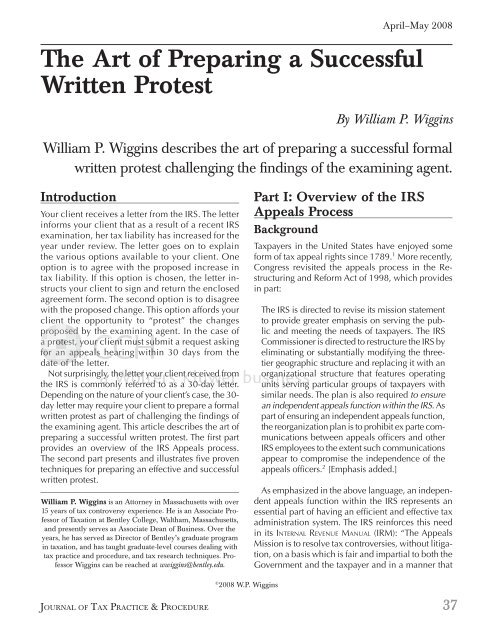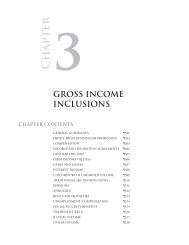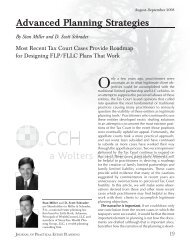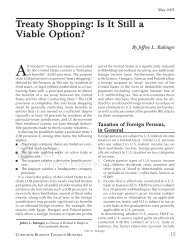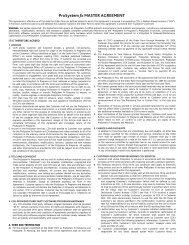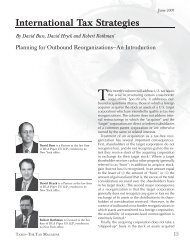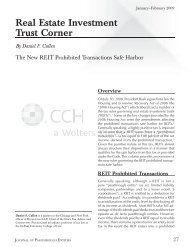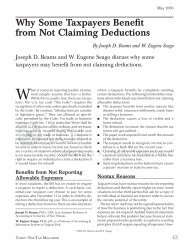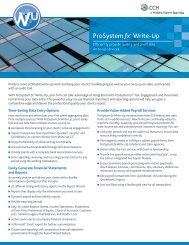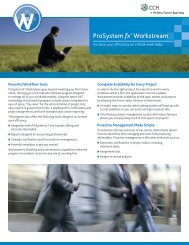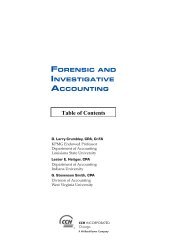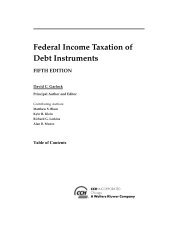The Art of Preparing a Successful Written Protest By William P ... - CCH
The Art of Preparing a Successful Written Protest By William P ... - CCH
The Art of Preparing a Successful Written Protest By William P ... - CCH
You also want an ePaper? Increase the reach of your titles
YUMPU automatically turns print PDFs into web optimized ePapers that Google loves.
April–May 2008<strong>The</strong> <strong>Art</strong> <strong>of</strong> <strong>Preparing</strong> a <strong>Successful</strong><strong>Written</strong> <strong>Protest</strong><strong>By</strong> <strong>William</strong> P. Wiggins<strong>William</strong> P. Wiggins describes the art <strong>of</strong> preparing a successful formalwritten protest challenging the findings <strong>of</strong> the examining agent.IntroductionYour client receives a letter from the IRS. <strong>The</strong> letterinforms your client that as a result <strong>of</strong> a recent IRSexamination, her tax liability has increased for theyear under review. <strong>The</strong> letter goes on to explainthe various options available to your client. Oneoption is to agree with the proposed increase intax liability. If this option is chosen, the letter instructsyour client to sign and return the enclosedagreement form. <strong>The</strong> second option is to disagreewith the proposed change. This option affords yourclient the opportunity to “protest” the changesproposed posby the examining agent. In the case <strong>of</strong>a protest, tyour client must submit a request askingfor an appeals phearing within 30 days from thedate <strong>of</strong>the letter.Not surprisingly, the letter your client received eivfromthe IRS is commonly mo yreferred rredto asa30-day yletter.eDepending on the nature <strong>of</strong> your client’s case, the 30-day letter may require your client to prepare a formalwritten protest as part <strong>of</strong> challenging the findings <strong>of</strong>the examining agent. This article describes the art <strong>of</strong>preparing a successful written protest. <strong>The</strong> first partprovides an overview <strong>of</strong> the IRS Appeals process.<strong>The</strong> second part presents and illustrates five proventechniques for preparing an effective and successfulwritten protest.<strong>William</strong> P. Wiggins is an Attorney in Massachusetts with over15 years <strong>of</strong> tax controversy experience. He is an Associate Pr<strong>of</strong>essor<strong>of</strong> Taxation at Bentley College, Waltham, Massachusetts,and presently serves as Associate Dean <strong>of</strong> Business. Over theyears, he has served as Director <strong>of</strong> Bentley’s graduate programin taxation, and has taught graduate-level courses dealing withtax practice and procedure, and tax research techniques. Pr<strong>of</strong>essorWiggins can be reached at wwiggins@bentley.edu.Part I: Overview <strong>of</strong> the IRSAppeals ProcessBackgroundTaxpayers in the United States have enjoyed someform <strong>of</strong> tax appeal rights since 1789. 1 More recently,Congress revisited the appeals process in the Restructuringand Reform Act <strong>of</strong> 1998, which providesin part:<strong>The</strong> IRS is directed to revise its mission statementto provide greater emphasis on serving the publicand meeting the needs <strong>of</strong> taxpayers. <strong>The</strong> IRSCommissioner is directed to restructure the IRS byeliminating or substantially modifying the threetiergeographic structure and replacing it with anorganizational on structure that features operatingunits sserving particular groups <strong>of</strong> taxpayers withsimilar needs. <strong>The</strong> plan is also required to ensurean independent appeals function within the IRS. Aspart <strong>of</strong> ensuring an independent appeals function,the reorganization plan is to prohibit ex parte communicationsbetween appeals <strong>of</strong>ficers and otherIRS employees to the extent such communicationsappear to compromise the independence <strong>of</strong> theappeals <strong>of</strong>ficers. 2 [Emphasis added.]As emphasized in the above language, an independentappeals function within the IRS represents anessential part <strong>of</strong> having an efficient and effective taxadministration system. <strong>The</strong> IRS reinforces this needin its INTERNAL REVENUE MANUAL (IRM): “<strong>The</strong> AppealsMission is to resolve tax controversies, without litigation,on a basis which is fair and impartial to both theGovernment and the taxpayer and in a manner that©2008 W.P. WigginsJOURNAL OF TAX PRACTICE & PROCEDURE 37
<strong>The</strong> <strong>Art</strong> <strong>of</strong> <strong>Preparing</strong> a <strong>Successful</strong> <strong>Written</strong> <strong>Protest</strong>will enhance voluntary compliance and public confidencein the integrity and efficiency <strong>of</strong> the Service.” 3What does this mission statement mean for taxpayersand those who represent them? In general terms, itmeans an independent pr<strong>of</strong>essional within the IRS (anAppeals Officer) will take a fresh look at a taxpayer’scase and work with the taxpayer (and representative)in search for a fair and impartial resolution to the taxcontroversy. In approximately 90 percent <strong>of</strong> all cases,a fair and impartial resolution is achieved. Indeed,the IRS reports on its Web site that over 100,000cases each year are successfully resolved throughthe appeals process.What Can I Expect When Workingwith an Appeals Officer?According to the IRM, Appeals Officers (AO) are expectedto exhibit the following characteristics whenmeeting with taxpayers and their representatives: 4Confidence in their job knowledgeResponsible actionA judicial attitude when applying tax law in areasonable and impartial mannerUniformity and consistency with respect to taxpayersin similar circumstances and achieving theprimary goal <strong>of</strong> resolving the disputeAccourteous manner when conducting conferences,providing an atmosphere <strong>of</strong> openness thatfosters cooperation operain theresolution <strong>of</strong> disputesGood listening skillsWhat does this definition n mean for you and yourclient? It means you will lhave anexperienced, eriencompetentand skilled tax pr<strong>of</strong>essional working with youto help find a fair resolution to your dispute. Typically,AOs have “come up through the system” and havemany years <strong>of</strong> experience in handling complex taxissues. AOs <strong>of</strong>ten possess advanced degrees and maybe attorneys or certified public accountants. <strong>The</strong> IRM’sdefinition <strong>of</strong> an “Appeals Office” also means that youwill be working with an IRS employee who sharesa common goal with you: to resolve tax disputes inan informal manner as quickly and efficiently as possible.As noted in the IRM: “Experience has shownthat when an AO is able to enlist the cooperation <strong>of</strong>taxpayers and representatives, cases are resolved ona mutually satisfactory basis with minimum expense,delay, and inconvenience to taxpayers.” 5AOs come from a variety <strong>of</strong> backgrounds andexperiences. Not surprisingly, their styles and theapproaches they use to settle tax controversiesvary. However, there are certain basic attributes38we can expect from all AOs. For example, theyare expected to:have an open mind and genuine interest inachieving a mutually acceptable agreement;set realistic target dates for the taxpayer and/or therepresentative to submit additional information,including proposals for settlement;complete the conference in a timely manner andmake accurate and prompt decisions;initiate frank discussions and not consider ideologicalkinds <strong>of</strong> arguments; andconduct conferences in an open atmosphere thatfosters cooperation in the resolution <strong>of</strong> disputes. 6Appeals conferences are informal. <strong>The</strong> discussionwith the AO is usually open and direct, yet sometimesunstructured. <strong>The</strong>re is much give and take. Unlike acourt setting, the AO will not ask that your testimonybe taken under oath. However, the AO may requestthat statements alleged as facts be submitted in theform <strong>of</strong> an affidavit or otherwise declared to be trueunder the penalties <strong>of</strong> perjury. Given the informality<strong>of</strong> an Appeals conference, meetings <strong>of</strong>ten occur in theAO’s <strong>of</strong>fice. If space is needed to present documentsor other kinds <strong>of</strong> visual materials, it is wise to contactthe AO in advance <strong>of</strong> the meeting to request a largerroom, <strong>of</strong>ten a conference room with a table.During the conference, the AO will review thestrengths and weaknesses <strong>of</strong> your client’s case. Youshould assume the AO is very familiar with the case.<strong>The</strong> discussion may start with the AO asking youquestions. Alternatively, the AO may invite you tomake an opening statement about the case. Becausethere is no particular protocol for discussing a case,you should be ready to follow the lead establishedby the AO or be ready to take the lead if <strong>of</strong>feredthe opportunity. <strong>The</strong>re is always the question aboutwhether the AO will raise a new issue or reopenan old issue during the conference. Typically, thisis not done unless the ground for such action is asubstantial one and the potential effect upon the taxliability is material. 7Taxpayers are allowed to represent themselves at anAppeals conference. Alternatively, they are allowedto have another person (a qualified representative)represent them. In general, a qualified representative isan enrolled agent, a certified public accountant, or anattorney authorized to practice before the IRS. Before aqualified representative is allowed to talk with an AO,the representative must complete a power <strong>of</strong> attorney(Form 2848—Power <strong>of</strong> Attorney and Declaration <strong>of</strong>Representative) and deliver it to the AO.
How Do I Request a Conferencewith an AO?Because appealing a case is a voluntary process, youmust make a request to have the case heard. <strong>The</strong>re isno filing fee. <strong>The</strong> IRS <strong>of</strong>fers several options for makinga request. For example, you may make an oralrequest for Appeals consideration in (1) all <strong>of</strong>ficeinterview or correspondence examination cases; or(2) a field examination case if the total amount <strong>of</strong>proposed additional tax including penalties, proposedover-assessment, or claimed refund (or, in an <strong>of</strong>fer incompromise, the total amount <strong>of</strong> assessed tax, penalty,and interest sought to be compromised) is $2,500 orless for any taxable period.In these situations, you arenot required to file a writtenprotest. 8On the other hand,taxpayers are requiredto prepare a brief writtenstatement (a formal written<strong>Protest</strong> is optional) toobtain Appeals considerationin a field examination case if the total amount<strong>of</strong> the proposed deficiency exceeds $2,500 butdoes snnotexceed $10,000 for any taxable period. 9Finally, a formal written protest is required in thefollowing owsituations:If thetotal amount <strong>of</strong> the proposed deficiencyexceeds $10,000 00 for any taxable period 10In all employee plan and dexempt emorganizationcases 11In all partnership and S corporation cases 12In some circumstances, you are allowed to makea small case request if the total amount for any onetax period is $25,000 or less by completing IRS Form12203. This form serves as an alternative to the requirement<strong>of</strong> submitting a written protest.<strong>The</strong> IRS may refuse to hear a case on appeal in certainsituations. For example, the Appeals Office willnot hear a case involving a deficiency based solelyon the failure or refusal to comply with the tax lawsbecause <strong>of</strong> moral, religious, political, constitutional,conscientious or similar grounds; and the IRS mayrefuse to hear an appeal where a preliminary review<strong>of</strong> the written protest indicates that it requires furtherwork or development. 13A taxpayer may, <strong>of</strong> course, choose not to requestan Appeals hearing. In this case the taxpayer willreceive a 90-day letter, which allows the taxpayerAppeals Officers come froma variety <strong>of</strong> backgrounds andexperiences. Not surprisingly, theirstyles and the approaches they useto settle tax controversies vary.April–May 2008to file a petition in the U.S. Tax Court. Finally, it isimportant to remember that making a request foran Appeals conference does not stop interest andpenalties from accruing. Interest and certain penaltieswill continue to accrue during the Appealsprocess. Under certain circumstances, you maymake a request to stop the accrual <strong>of</strong> interest andpenalties on proposed adjustments. 14How Long Does theAppeals Process Take?According to the IRS Web site, once you have submitteda written <strong>Protest</strong>, you will usually hear from theapplicable Appeals Office within 90 days. If morethan 90 days have passed,you should contact the<strong>of</strong>fice where you sent theprotest. <strong>The</strong> IRS employeesat this <strong>of</strong>fice should beable to tell you when theysent your case to the AppealsOffice. If, for somereason, they were delayedin sending your protest toAppeals, you should expect to hear from someone inthe Appeals Office not later than 90 days from whenthe protest was forwarded to Appeals. If more than 90days have passed from this date, you should contactthe original <strong>of</strong>fice where your written protest was sentand ask for the name and contact information <strong>of</strong> theAOassigned sigtothe case. Once your protest has beenreceived by yanAO, it generally takes anywhere from90 days to a year to resolve the dispute.What Results Can I Expect from theAppeals Process?If after consideration <strong>of</strong> the case by an AO a satisfactorysettlement is reached between the taxpayerand the government, the taxpayer will be asked tosign Form 870-AD (or a similar agreement formdepending on the circumstances). <strong>By</strong> signing Form870-AD, the taxpayer agrees to waive restrictions onthe assessment and collection <strong>of</strong> any deficiency, andagrees to accept any over-assessment resulting fromthe agreed settlement. 15 On the other hand, if a satisfactorysettlement is not reached, a statutory notice<strong>of</strong> deficiency will be issued. Once this process hasoccurred, the taxpayer has the right to file a petitionwith the U.S. Tax Court for a redetermination <strong>of</strong> thedeficiency. <strong>The</strong> filing must occur within 90 days <strong>of</strong>the mailing <strong>of</strong> the statutory notice <strong>of</strong> deficiency. 16JOURNAL OF TAX PRACTICE & PROCEDURE 39
<strong>The</strong> <strong>Art</strong> <strong>of</strong> <strong>Preparing</strong> a <strong>Successful</strong> <strong>Written</strong> <strong>Protest</strong>Part II: <strong>The</strong> <strong>Art</strong> <strong>of</strong> <strong>Preparing</strong> a<strong>Successful</strong> <strong>Written</strong> <strong>Protest</strong>Is <strong>The</strong>re Official Guidance on Howto Prepare a <strong>Written</strong> <strong>Protest</strong>?<strong>The</strong> IRS provides minimal guidance regarding thepreparation <strong>of</strong> a written protest. Unlike many otherIRS procedures, the IRS does not require the completion<strong>of</strong> a form when filing a protest. <strong>The</strong> regulationsprovide that “instructions for the preparation <strong>of</strong>written protests are sent to the taxpayer with the transmittal(30-day) letter.” 17 <strong>The</strong> current set <strong>of</strong> instructionsincluded with the 30-day letter takes the form <strong>of</strong> IRSPublication 5. 18 <strong>The</strong> instructions include in Publication5 are relatively straightforward and include thefollowing basic requirements:Taxpayer’s name and address, and a daytimetelephone numberA statement that the taxpayer wants to appeal theIRS findings to the Appeals OfficeA copy <strong>of</strong> the letter showing the proposed changesand findings the taxpayer doesn’t agree with(or the date and symbols from the letter)<strong>The</strong> tax periods or years involvedA list <strong>of</strong> the changes that the taxpayer doesn’tagree e with, and why the taxpayer doesn’t agree<strong>The</strong>facts supporting the taxpayer’s position onanyissue that the taxpayer doesn’t agree with<strong>The</strong>elaw or authority, if any, on which the taxpayeris relying<strong>The</strong> taxpayer’s signature on the written protest,stating that it is true, under the penalties <strong>of</strong> perjuryas follows: “Under the penalties <strong>of</strong> perjury,I declare that I examined the facts stated in thisprotest, including any accompanying documents,and, to the best <strong>of</strong> my knowledge and belief, theyare true, correct, and complete.”While the simplicity <strong>of</strong> these instructions is refreshing,particularly when compared with other IRS formsand publications, its brevity leaves taxpayers andrepresentatives with virtually no guidance on theactual preparation <strong>of</strong> a written protest. Consequently,a wide range <strong>of</strong> approaches are available, with noone method trumping the other.<strong>The</strong> remainder <strong>of</strong> this article presents and discusses aset <strong>of</strong> proven techniques for preparing a successful writtenprotest. While recognizing that not all aspects <strong>of</strong> preparinga successful written protest can be covered in onearticle, the five techniques presented in Table 1 shouldbe considered whenever preparing a written <strong>Protest</strong>.40Prepare a Roadmap and RememberThat Presentation Matters 19Don’t spend all your time meeting with the client,gathering facts and conducting legal research. Thisis a mistake many taxpayer representatives makewhen preparing a written <strong>Protest</strong>. Too <strong>of</strong>ten, notenough time is spent on planning and presentation.Let us remember that a 30-day letter imposes a tighttimetable. Good planning is essential. As the sayinggoes, “plan the work; work the plan.” And, asyou plan the work, be sure to leave enough time forwriting (developing an effective presentation). Manyhours dedicated to discovering facts and finding relevantlegal authorities can be obfuscated quickly ifyou don’t have sufficient time to prepare a polishedproduct. Remember, the first impression an AO willhave regarding the representation <strong>of</strong> your client’s caseis your written protest. <strong>Preparing</strong> a polished writtenprotest does not simply happen. It requires goodplanning, organization and writing.Table 1. Five Techniques for <strong>Preparing</strong> a<strong>Successful</strong> <strong>Written</strong> <strong>Protest</strong>Prepare a roadmap and remember thatpresentation mattersFocus on factsDevelop logical and convincing argumentsCritique thereport <strong>of</strong> the examining agentRevise, revise again and revise one more timeA few classic statements about planning and presentation:Matter and manner—we cannot escape them.When they are at one, when what is said has aperfect correspondence with the way <strong>of</strong> sayingit, we have good writing (or speech) on anylevel. But when this law <strong>of</strong> appropriateness isbroken, writing (or speech) becomes in varyingdegrees bad. 20<strong>The</strong> law <strong>of</strong> attention requires that all writingshould reach the comprehension <strong>of</strong> the reader inthe easiest way and with instant clearness. Writingmay be likened to a window through whichthe writer shows the reader a view without. If theglass is poor it will distort the view and irritate
April–May 2008the beholder. Glass made ornate with jewels willdraw to itself a part <strong>of</strong> the attention, and thus impairinterest in the view. <strong>The</strong> best window-glassis plate, a strong and highly finished product soclear that one looking through it is unconscious<strong>of</strong> its presence. 21Let’s consider the following illustration to reinforcethe point about planning and preparation. If you wereplanning a trip to a city located a thousand miles fromyour home, would you simply get into your car andstart driving? Not likely! Most <strong>of</strong> us would prepare anitinerary, prepare a list <strong>of</strong> items to bring with us, andchart our course by using a roadmap. In other words,we would spend a fair amount <strong>of</strong> time planning thetrip before starting the engine.Likewise, before you start to write a protest, taketime to organize your thoughts. Prepare a rough outline,a roadmap. Although different structures existfor preparing a written protest, the following topicalheadings are customary:Issue(s)Proposed Adjustment(s)FactsLawIRS ExaminationArgumentConclusionnUnder each <strong>of</strong> these headings, develop subheadings.ngs.For example, let’s assume that one <strong>of</strong> the issuesraised by the examining ng agent involves excessiveescompensation. Under the Facts heading, howwouldyou organize your presentation? Would you have asubheading focusing on the biographical descriptions<strong>of</strong> key employees? Would you have anothersubheading describing the company and the nature<strong>of</strong> its business? Would you have yet another subheadingdealing with financial data about compensationpaid to key employees?<strong>The</strong>se are the types <strong>of</strong> questions you must ask andanswer before you begin to write. Otherwise, yourpresentation will be confusing at best, incoherent atworst. In the end, it doesn’t matter how you organizethe different components <strong>of</strong> your written protest; whatmatters is that you have a plan for structuring andorganizing your protest (a roadmap), and that you usethis plan consistently throughout your presentation.Finally, remember that a good presentation requiresmore that good planning and organization. It alsorequires good writing. Bad writing is distracting. Itdistorts what otherwise might be a fine product. Foran AO who knows the rules <strong>of</strong> grammar, it is highlyannoying to see fundamental grammatical errors ina <strong>Protest</strong>. Beyond the annoyance factor, however, isa far more serious problem. Bad writing has the potential<strong>of</strong> diverting the AO’s attention from the pointyou are trying to make. What to do? <strong>Successful</strong> andaccomplished writers have a good handbook at theirsides whenever they write. As you prepare your writtenprotest, have a handbook at your side. If you areunsure about the punctuation <strong>of</strong> a particular sentence(e.g., do these sentence parts call for a comma or asemicolon), look it up. Don’t guess.Focus on FactsRegardless <strong>of</strong> what factual information you decideto include under each topical heading and subheading,you must also determine the order in which topresent the facts. Consider the following illustration.If you plan to drive from Boston to Chicago, it is unlikelythat you would drive first to Baltimore, then toNashville and finally to Chicago, unless <strong>of</strong> course timeand money were <strong>of</strong> no concern. Likewise, an AO willexpect to see some logical order to the presentation <strong>of</strong>the facts in your written <strong>Protest</strong>. Don’t confuse the AOby driving from Boston to Chicago via Nashville!Fortunately, a variety <strong>of</strong> techniques exist for orderingthe presentation <strong>of</strong> facts: there is the chronologicalapproach (e.g., emphasizing the timing and sequence<strong>of</strong> key events); there is the biographical approach(e.g., describing key individuals along with facts associatedwith them); and there is the transactionalapproach ach((e.g., e g focusing on the transfer <strong>of</strong> resourcesfrom one taxpayer to another). Again, it doesn’t matterwhat approach you use in ordering the presentation <strong>of</strong>facts in your protest; what matters is that you have anapproach and you employ it consistently throughoutyour presentation.Your statement <strong>of</strong> facts should also tell your client’sstory. James W. McElhaney makes the following pointin his article, “Humans always have used the story tounderstand facts and resolve issues. Everything in thelaw is a story. Every case, every motion, every brief isa story. <strong>The</strong> winning brief needs to tell a persuasivestory. Lots <strong>of</strong> thoughtful judges admit they start to takesides—lean one way or another—as soon as they readstatements <strong>of</strong> facts. <strong>The</strong> statement <strong>of</strong> facts is the mostimportant part <strong>of</strong> the brief because it points the wayto elemental justice.” 22According to McElhaney, there are lots <strong>of</strong> ways towrite a statement <strong>of</strong> facts; however, a good statementpasses two essential tests.JOURNAL OF TAX PRACTICE & PROCEDURE 41
<strong>The</strong> <strong>Art</strong> <strong>of</strong> <strong>Preparing</strong> a <strong>Successful</strong> <strong>Written</strong> <strong>Protest</strong>1. It stands alone. Anyone reading your statement<strong>of</strong> facts should understand what the case is aboutwithout having to look at anything else.2. <strong>The</strong> statement <strong>of</strong> facts should make the readertake your side. It should be persuasive withoutbeing argumentative. 23<strong>The</strong> point here is that facts, not opinions, willconvince the AO to look favorably upon your client’scase.We need also to consider the unique role that factsplay in an IRS Appeals case. As Table 2 demonstrates,the taxpayer’s representative enjoys certain strategicadvantages over the AO. How? <strong>The</strong> representativecontrols the facts in ways that the AO does not. Forexample, AOs do not prepare their own cases. AOsare not fact-finders. <strong>The</strong>y are dependent on the examiningagent for the discovery, presentation andanalysis <strong>of</strong> the facts in a case.As suggested by Table 2, there are certain uniquecharacteristics <strong>of</strong> the IRS Appeals process thatmay work in the taxpayer’s favor. For example, if aparticular examining agent possesses inadequateinvestigative skills, the development <strong>of</strong> the facts inthe agent’s report is likely to be <strong>of</strong> low value. Nonetheless,the AO must deal with that which has beendelivered by the examining agent. On the other hand,the representative is not dependent on the abilitiesand skills <strong>of</strong> another person. If the representative hasstrong investigative skills, the statement <strong>of</strong> facts in theprotest tislikely to be <strong>of</strong> high quality.<strong>The</strong> process by which an examining agent discoversfacts also has the epotential <strong>of</strong> impairing an AO’s sunder-standing <strong>of</strong> a case. Typically, an agent discovers factsthrough the use <strong>of</strong> an Information Document Request.This process can be slow and cumbersome, usuallyresulting in the examining agent being highly selectivein the fact-gathering process. Budget constraints mayalso limit the extent to which an agent discovers facts,particularly given that most IRS audits are limited interms <strong>of</strong> time, scope and budget. On the other hand, arepresentative enjoys unlimited access to a client’s recordsand other forms <strong>of</strong> evidence, allowing for a robustdiscovery and development <strong>of</strong> relevant facts.In the end, it is important to remember that AOsreceive facts from two sources: the examining agent’sreport and the written protest prepared by the taxpayer’srepresentative. Accordingly, don’t miss thisunique opportunity to tell your client’s story in a waythat makes the AO take your side. Remember—facts,not opinions, represent the ingredients <strong>of</strong> a successfulwritten protest.Develop Logical andConvincing ArgumentsDeveloping a logical argument requires the repetitiveapplication <strong>of</strong> the following model:Present the questions (issues) raised by the examiningagentPresent your answers to the questionsPresent the reason(s) for your answerWhen considering this model, it is useful to thinkabout the reasons why we are sometimes ineffectivein developing logical and convincing arguments.First, we include facts in the argument that areunconnected ed to the question being asked. In anygiven case, many facts exist. During the discoveryprocess, we unearth all kinds <strong>of</strong> interesting facts. Unfortunately,not all interesting facts are relevant facts.Table 2. <strong>The</strong> Unique Role That Facts Play in an IRS Appeals CaseAppeals OfficerTaxpayer’s RepresentativeNot a fact-finder; must rely on the examiningagent’s reportDependent on the investigative skills, trainingand abilities <strong>of</strong> the examining agentDoes not prepare the factual presentationDiscovery limited by the scope (and budget)<strong>of</strong> the examinationBurden <strong>of</strong> pro<strong>of</strong> “advantage” may diminishthe quantity and quality <strong>of</strong> the fact gatheringdone by the examining agent42Is a fact-finder; not bound by facts presented inthe examining agent’s reportRelies on own skills and abilitiesPrepares independent factual presentationDiscovery not limited by scope (or budget) <strong>of</strong>the examinationBurden <strong>of</strong> pro<strong>of</strong> “challenge” may enhance thequantity and quality <strong>of</strong> the fact gathering doneby the taxpayer’s representative
April–May 2008Discipline is essential. We must constantly remindourselves to include only those facts that are requiredto answer the question asked (issue raised) by theexamining agent. Nothing more, nothing less!Secondly, we inject irrelevant law into the argument.Too <strong>of</strong>ten we are enamored with the law. Weread an interesting case and become fascinated byit. However interesting, some cases or other legalauthorities have little bearing on the augment beingdeveloped. Including unnecessary legal authorizes inyour argument is a mistake. It serves only to distractthe attention <strong>of</strong> the AO, thus weakening your argument.Again, discipline is essential here.Finally, we fail to make logical connections betweenissues, facts and law. We might be diligent inincluding only those facts and law that are essentialto answering the question posed; however, we don’ttake the next step <strong>of</strong> connecting them. To develop aconvincing argument, we need to connect the facts tothe law in such a way as to create a coherent “whole,”not just a presentation <strong>of</strong> relevant, but unconnectedfragments <strong>of</strong> facts and law. Look for the thread thatties issues, facts and law together. Test the plausibility<strong>of</strong> your argument. Is your response to the questionasked supported by underlying facts, or have youmade assumptions that cause your argument to bevulnerable? Have you adequately applied the law tothe facts, or does your presentation <strong>of</strong> legal authoritiesappear to serve no other purpose other than fillingthe page? Frequently, we spend too much time gatheringlegal authorities, but then fail to “put the lawto work” in developing the argument. Every statute,case, regulation and ruling included in your protestshould work to support your argument. If certaincases or rulings are not “working” to support yourargument, get rid <strong>of</strong> them.<strong>The</strong> traditional method for making connections ina legal argument is through the use <strong>of</strong> analogical reasoning.In general, analogical reasoning is a form <strong>of</strong>reasoning that allows us to connect issues with factsExample 1. Analogical Reasoning *Suppose, for example, that a court faces a case in which the defendant, a contractor, found buriedmoney under the plaintiff’s garage. <strong>The</strong> court surveys past cases having to do with things lost and foundand finds the following:Several cases in which someone found money on the floor <strong>of</strong> a shop or similar premises andthecourts held that the finder was entitled to retain possession as long as the owner <strong>of</strong> the lostproperty pwas notknownSeveral cases in which someone found money on a table in a shop or on a chair in a bank safedeposit room and the courts held that the owner <strong>of</strong> the place where the money was found wasentitled topossessionoA case in which someone found a brooch on a window ledge in a house temporarily requisitionedby the government and the court held that the finder was entitled to possession<strong>The</strong> court might then propose the following analogy—warranting rule: when property is found incircumstances that suggest its owner set it down deliberately and then forgot it, the right to possessionshould go to the owner <strong>of</strong> the place where the property was found. If, however, it seems that the ownerdropped the property inadvertently, possession should go to the finder. This rule leaves one possiblyrecalcitrant case (the case <strong>of</strong> the brooch), but the rule appears to be justified by a broader analogy—warranting rationale—that owners who have set property down and then forgotten it are more likely toreturn to the site than those who have dropped their property inadvertently. <strong>The</strong> more likely the owneris to return, the less appealing it is to award the property to finders who are comparatively more difficultfor the owner <strong>of</strong> the lost property to trace. <strong>The</strong>se ideas in turn can be tested at higher levels <strong>of</strong> generality:a rule designed to return lost property to its owner will make property rights more secure, secureproperty rights contribute to general prosperity, and so forth. <strong>The</strong> analogy-warranting rule can also betested against hypothetical future cases to see if it produces satisfying outcomes. If the results <strong>of</strong> testingare acceptable, and if we assume that the prior decisions were correct, we may now have some reasonto believe that the money found under the garage should stay with the owners <strong>of</strong> the house.*This example is from Emily Sherwin, A Defense <strong>of</strong> Analogical Reasoning in Law, 66 U. CHI. L. REV. 1179 (1999), at 1182–83.JOURNAL OF TAX PRACTICE & PROCEDURE 43
<strong>The</strong> <strong>Art</strong> <strong>of</strong> <strong>Preparing</strong> a <strong>Successful</strong> <strong>Written</strong> <strong>Protest</strong>and legal authorities. <strong>The</strong> basic idea is that throughthe use <strong>of</strong> analogies judges (and other decisionmakers,e.g., AOs) will follow the course suggestedby the analogy and thus conform their decisions tothe existing body <strong>of</strong> law. 24How does analogical reasoning work? As commonlypracticed, it works something like this:“Confronted with an unsettled question, the judgesurveys past decisions, identifies ways in which thesedecisions are similar to or different from each otherand the question before her, and develops a principlethat captures the similarities and differences sheconsiders important. This principle in turn providesthe basis for the judge’s own decision. Whatever onemay think about the merits <strong>of</strong> analogical decisionmaking,there is little question that judges writingopinions and lawyers addressing judges <strong>of</strong>ten casttheir analysis in this form.” 25 Example 1 illustratesanalogical reasoning.What lessons can we learn from Example 1? First,every argument in your written protest must have alogical flow that uses analogies to connect the factsin your case with the legal authorizes you have cited.Secondly, make the AO’s job easier by providing asurvey <strong>of</strong> past decisions and other relevant legal authorities.Thirdly, point out the ways in which theseauthorities are similar to or different from each other,and relate e them to the issues and facts in your case. Finally,show the AOthe logical conclusion that shouldbe ereached through the use <strong>of</strong> the analogies.Critique the Report <strong>of</strong> theExamining AgentOur discussion about the art <strong>of</strong> preparing a successfulwritten protest would not be complete without adiscussion about the need to critique the report <strong>of</strong> theexamining agent. <strong>Preparing</strong> a convincing and compellingargument on behalf <strong>of</strong> our client is not enough.Why? <strong>The</strong> examining agent may have prepared anequally strong argument on behalf <strong>of</strong> the government.If this is the case, the AO may have to decide betweentwo equally strong arguments. Your job in preparingthe protest is to help make the decision easier for theAO. You can accomplish this task by critiquing the caseas developed by the examining agent. Based on ourearlier discussion about how to develop a successfulwritten protest, consider the following methods forcritiquing the examining agent’s report.First, review the agent’s development <strong>of</strong> the facts. Is thedevelopment complete? Are the stated facts relevant tothe issue raised by the agent? Are there inconsistencies44in the agent’s presentation <strong>of</strong> the facts? Are there inconsistenciesin the agent’s presentation <strong>of</strong> the facts whencompared to your presentation <strong>of</strong> the facts? Has the agentused the facts to tell a story? Is there a logical flow to thepresentation <strong>of</strong> the facts, and so forth? In other words,don’t allow the agent’s presentation <strong>of</strong> the facts to gounchallenged. If the presentation is incomplete, point itout. If the facts are inconsistent, point it out. If the presentation<strong>of</strong> the facts fails to tell a convincing story, point itout. Don’t leave it to the AO to make these observations.<strong>By</strong> showing inconsistencies and other problems withthe facts, as developed and presented by the examiningagent, you begin to win the confidence <strong>of</strong> the AO.Secondly, scrutinize the quality and quantity <strong>of</strong> thelegal research conducted by the examining agent. Determineif the agent identified all relevant legal authorities.Assess whether the agent used the cited legal authoritiescorrectly. Did the agent properly interpret the law? Didthe agent correctly apply the law to the issue and thefacts in the case at hand? Did the agent include legalauthorities in the report, but not use them in the analysisor argument? Don’t leave these questions unanswered.If there are flaws in the legal research conducted by theagent, or flaws in the ways by which the agent used thecited legal authorizes, point it out. Again, don’t leave itto the AO to make these observations.Finally, test the examining agent’s arguments. Hasthe agent adequately connected the issues with thefacts and the law? Have convincing analogies beendeveloped by the agent? Has the agent adequately answereded the questions asked (issued raised) in the agent’sown report? If fthere are flaws in the agent’s argument,point them out. Obviously, AOs will draw their ownconclusions. <strong>The</strong>y are at liberty to accept or reject thepoints you make in your written <strong>Protest</strong>. However, byconducting a review <strong>of</strong> the examining agent’s report,you will have achieved the goal <strong>of</strong> inviting the AO toconsider the quality <strong>of</strong> the work done by the agent.Revise, Revise Again and ReviseOne More Time<strong>The</strong>re is no such thing as good writing. <strong>The</strong>re isonly good rewriting. 26Justice Brandeis was known for revising his opinions15 or more times before he was satisfied withthe final product. I am not suggesting that theaverage person preparing a written protest revise it 15 ormore times. However, you should revise it at least threetimes, more if time and money permit. Sometimes, by
April–May 2008investing several hours to review and revise your protest,you protect the many hours you spent in gathering facts,conducting legal research and preparing your arguments.Excessive use <strong>of</strong> the passive voice, timid phrases,vague words and other examples <strong>of</strong> poor writing are<strong>of</strong>ten found in first drafts. After all, a first draft is a roughdraft. It is not a finished product. You will have (and theAO will enjoy) a finished product after you have revisedit at least three times.ConclusionDespite the many hours taxpayer representatives <strong>of</strong>teninvest in preparing a written protest, they may failto convince an AO to view their case more favorablythan the government’s case. This result may occur becausethe representative accepted an inherently weakcase. For example, the facts or legal authorities mayfail to support the client’s position on a particular issue.On the other hand, the representative may have astrong case with which to work, but nonetheless failsto develop a successful written protest. Sometimes,there is not much that can be done when handlingan inherently weak case. However, as this articledemonstrates, regardless <strong>of</strong> the inherent strengths orweaknesses <strong>of</strong> a given case, there is much that canbe achieved by mastering the art <strong>of</strong> preparing a successfulwritten protest.1<strong>The</strong> Act <strong>of</strong> 1789 that created the TreasuryDepartment in the newly established UnitedStates <strong>of</strong> America gave the right to appealadverse tax decisions to the comptroller <strong>of</strong>the United States.2Restructuring and Reform Act <strong>of</strong> 1998 (P.L.109-171).3IRM 8.1.1.1(1) (Oct. 23, 2007).4IRM 8.1.3.4(1) (Oct. 23, 2007).5IRM 8.1.3.4(5) (Oct. 23, 2007).6IRM 8.6.1.3 (Nov. 6, 2007).7IRM 8.6.1.6 (Nov. 6, 2007).8 Reg. §601.106(a)(1)(iii)(a).9 Reg. §601.106(a)(1)(iii)(b).10Reg. §601.106(a)(1)(iii)(c).ENDNOTES11Reg. §601.106(a)(1)(iii)(d).12Reg. §601.106(a)(1)(iii)(e).13Reg. §601.106(b).14See Notice 1016, How to Stop Interest. Foran explanation on how to stop interest fromaccruing on an unpaid balance, refer to IRSPublication 594.15Reg. §601.106(d)(2)(i).16Reg. §601.106(d)(2)(ii).17Reg. §601.105(d)(2)(v).18IRS Publication 5 (Rev. 01-1999), CatalogNumber 460741.19Many <strong>of</strong> the recommendations presentedin this section <strong>of</strong> the article are based onideas developed from a close reading <strong>of</strong> THEELEMENTS OF LEGAL STYLE BY BRYAN A. GARNER(Oxford UP: 2002).20G.H. Vallins, THE BEST ENGLISH 199 (1960).21W.C. Morrow, THE LOGIC OF PUNCTUATION 14(1926).22James W. McElhaney, Legal Writing thatWorks, 93 A.B.A.J. 31 (2007).23Id., at 31–32.24Emily Sherwin, A Defense <strong>of</strong> AnalogicalReasoning in Law, 66 U. CHI. L. REV. 1179(1999).25Id., at 1179–80.26Justice Louis Brandeis (George W. Pierce,<strong>The</strong> Legal Pr<strong>of</strong>ession, 30 THE TORCH 5, at 8(1957) (quoting Justice Brandeis).This article is reprinted with the publisher’s permission from the JOURNAL OF TAX PRACTICE &PROCEDURE, a bi-monthly rinedyj journal lppublished by yC<strong>CCH</strong>, sa Wolters Kluwer business. Copying ordistribution without the publisher’s permission is prohibited. To subscribe to the JOURNAL OFTAX PRACTICE & PROCEDURE or other <strong>CCH</strong> Journals please call 800-449-8114 or visitwww.<strong>CCH</strong>Group.com. All views expressed in the articles and columns are those<strong>of</strong> the author and not necessarily those <strong>of</strong> <strong>CCH</strong>.JOURNAL OF TAX PRACTICE & PROCEDURE 45


